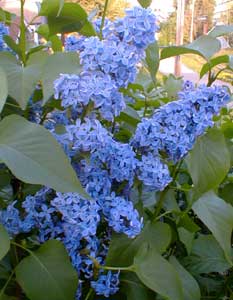
Blue French Lilac
"April is the
cruelest month, breeding
Lilacs out of the dead land."
-The Waste Land
T. S. Eliot
(1888-1965)
T. S. Eliot
(1888-1965)
The blue Lilac tree is about fifteen feet tall. It is part of our lower hillside neighbor's hedge of lilac trees (or large shrubs). His property is at the foot of a sheer stone wall behind our property edge. Our garage appears as though "sunken" from atop our property, so it serves as our ground-level "deck," fenced on the side of the sheer drop. From the lower-street point of view, the garage wall extends the high stone wall out to the street edge. And the giant hedge of mixed purple, white, & blue lilacs appears from our perspective on the fenced roof-deck to be a short hedge. From our garage rooftop deck, the lilacs appear to be only head-tall, & we can press our noses to their uppermost flowers.
What a wonderful perfume & flowery beauty it is in April & May. It is almost as though our neighbor planted these for our benefit, though of course his personal goal was to disguise the grey wall of the garage.
The color of our own Dark Purple Lilac is closer to the color of lilac blooms in their original wild settings in mountains of southwestern Europe. But these pale blues are just about the oldest of all cultivated colors, having been hybridized in France & popularized throughout Europe & North America by the 1880s.
The first settlers in what became New England brought older, wilder forms of the shrub with them to America. Even though it was purely ornamental in a time when the basics of survival had precedence, lilacs have nevertheless been in North America for just about as long as there have been European immigrants to the continent. It was one of the few familiar ornamentals that thrived in the harshest New England winters, & there is an element to the human psyche that requires something besides the practical.
It is today the state flower of New Hampshire, called "the flower of the home," & no Vermont or New Hampshire town or city is without them. New England archeology relies on old stands of lilacs descended from pioneer plantings, as evidence of old settlements & lost graveyards.
Even here in the Pacific Northwest, so recently populated by white immigrants compared to how long Europeans have been in New England, lilacs arrived together with the settlers. For example, the "Red River pioneers" were so-called because in 1841 they came down from the Red River settlement in Canada, & established their community on land that is today Fort Lewis. They marked their cemetery with lilacs, which can be seen to this day flowering in the Old Indian Hill Cemetery. For most of our historic cemeteries it is the same.
There is a sacredness about lilacs that dates at least to medieval Europe, & this is why it became a common shrub or tree for churchyard cemeteries. The use of lilacs in churchyards may have originated in practical considerations, since the overwhelming perfume of the lilacs would mask even the odor of a corpse. But the tradition has never flagged, & the most common flower brought to New England, Midwest, & Northwest gravesites each Memorial Day are still the lilacs.
Wild dark purple lilacs can reach thirty-five feet in height, & sucker to an equal width. The modern cultivated forms only rarely exceed twenty feet, & for the majority of varieties, ten to fifteen feet would be as big as they come. Even so, this old-fashioned pale blue French hybrid shot up to above the garage roof in a very few short years, growing only slightly slower than the even larger pure white lilac next to it.